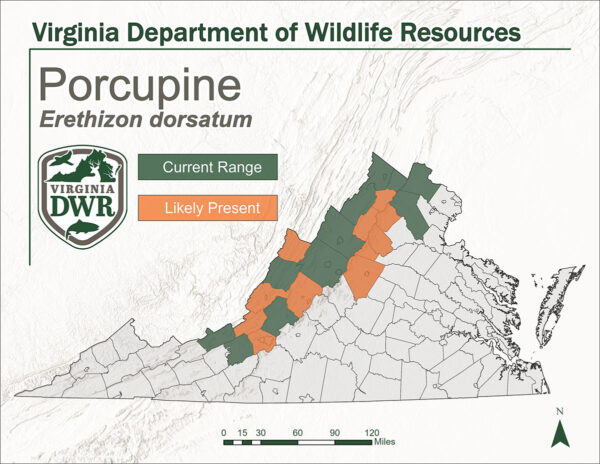Fact File
Scientific Name: Erethizon dorsatum
Classification: Mammalia, Order Rodentia, Family Erethizontidae
Distribution
Porcupine were historically present in Virginia but were likely extirpated from the state by the mid-1800s. There were a few reports of porcupines observed in Virginia in the late 1900s. In recent decades, populations have been increasing in Pennsylvania and West Virginia resulting in a range expansion southward and westward into Virginia. An increasing number of porcupines have been observed in Virginia over the past 20 years, predominantly in the northern and western counties. (Porcupines have been confirmed in the following VA counties: Augusta, Bath, Botetourt, Clarke, Fauquier, Frederick, Giles, Loudoun, Montgomery* (this animal was suspected to be intentionally released or accidentally transported), Rockingham, and Shenandoah).
DWR is actively seeking reports of porcupines in the state. If you have any verifiable information (i.e., photos, video, etc.) regarding the occurrences of porcupines in Virginia, please enter your information at DWR’s Rare Animal Observation Form.

Identifying Characteristics
Adult porcupines on the average weigh from 4 to 6 kg, and are from 60 to 100 cm long. This is the only mammal in North America that has coat hairs which are modified as quills. The coat tends to be dark colored, although chestnut, cream, brown, gray, and albino porcupines have been seen. The porcupine has a small face, with a blunt muzzle, and a tapering head and neck. The tail is short and stout. The feet of the porcupine resemble those of a bear, with four long claws on the front feet and five on the hind feet. Breeding season is from September to November and one precocial pup is born in late April or early May. Porcupines are nocturnal and tend to be solitary except during the breeding season, but they may den together in the wintertime. Having poor vision, porcupines rely primarily on their good sense of hearing and of smell, sometimes standing up on their hind legs to sniff the air. They remain motionless when mildly threatened, but when they feel that they are in greater danger, they will erect their quills and seek a sheltered place to protect their head. Vocalizations of the porcupine, though used infrequently, include various screeches and calls.
Diet
In the winter, they eat the cambium, phloem, and leaves of woody shrubs and small trees, especially hemlock. In the spring and summer, porcupines feed primarily on the ground, consuming various forbs and grasses, including sedges, dandelions, violets, clover, alfalfa, and grains.
Last updated: October 15, 2025
The Virginia Department of Wildlife Resources Species Profile Database serves as a repository of information for Virginia’s fish and wildlife species. The database is managed and curated by the Wildlife Information and Environmental Services (WIES) program. Species profile data, distribution information, and photography is generated by the Virginia Department of Wildlife Resources, State and Federal agencies, Collection Permittees, and other trusted partners. This product is not suitable for legal, engineering, or surveying use. The Virginia Department of Wildlife Resources does not accept responsibility for any missing data, inaccuracies, or other errors which may exist. In accordance with the terms of service for this product, you agree to this disclaimer.

